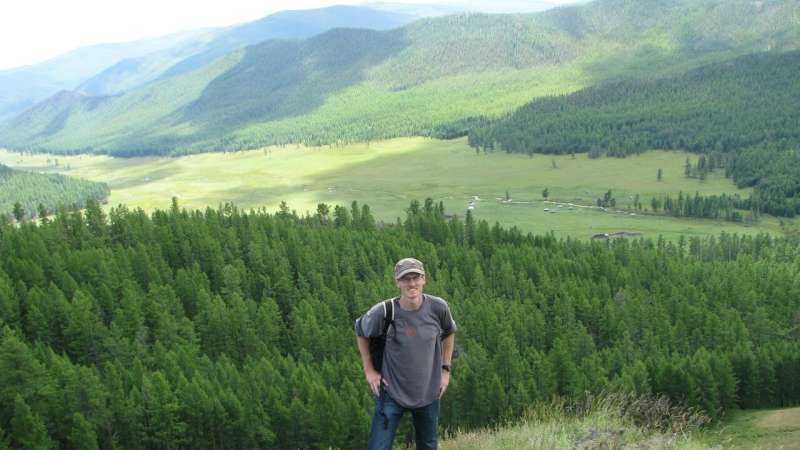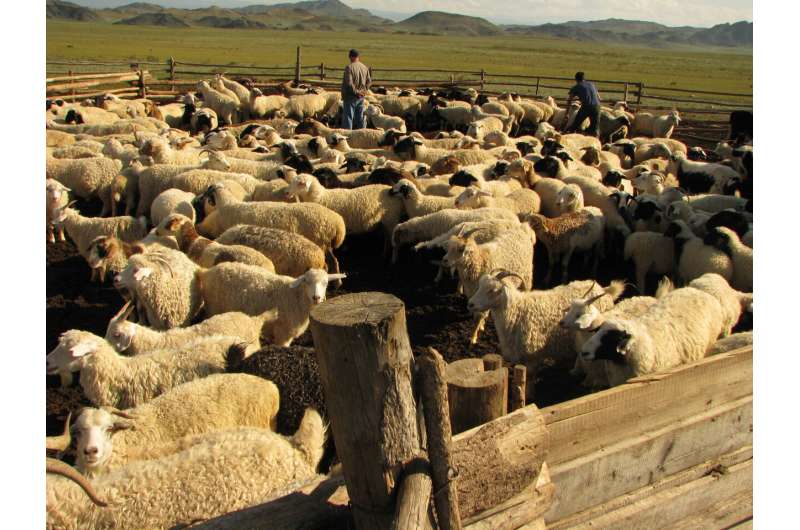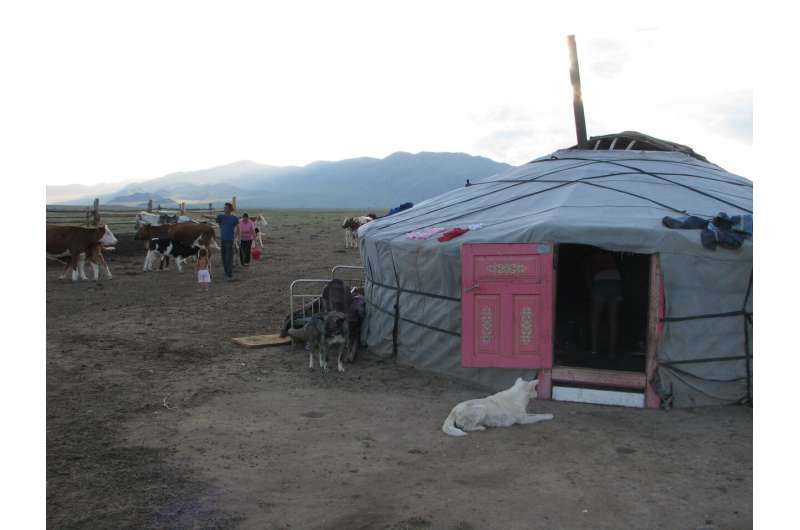This article has been reviewed according to Science X's editorial process and policies. Editors have highlighted the following attributes while ensuring the content's credibility:
fact-checked
trusted source
proofread
Anthropologist examines nomadic pastoralists in Russia

For centuries, nomadic pastoralists have been moving their livestock with the seasons between camps at the headwaters of the Yenisei River in Tuva in Russia and northern Mongolia. In new research, Adjunct Associate Professor of Anthropology at The University of New Mexico Paul Hooper examines the use and informal ownership of these camps depending on season and how they illustrate evolutionary and ecological principles underlying variation in property relations.
According to the research, "given relatively stable patterns of precipitation and returns to capital improvement, families generally benefit from reusing the same camps year after year. We show that locations with higher economic defensibility and capital investment—winter camps and camps located in mountain/river valleys—are claimed and inherited more frequently than summer camps and camps located in open steppe."
Hooper carried out his research in Tuva and Mongolia over a four-year period. The findings are published in the journal Philosophical Transactions of the Royal Society B: Biological Sciences.
"I traveled with a small team in a four-wheel-drive van to visit families at their camps up in the region's high mountain valleys. We drank hundreds of bowls of milk tea while listening to family histories and stories of migration. People would study the maps with concentration in order to point out the best locations to forage wild blueberries during the summer. The herders know and appreciate their landscape at a level that I found inspiring. The generosity of families in hosting us was also just exceptional," he said.
Hooper defined nomadic pastoralists as people who specialize in raising livestock, moving with their herds to maximize the health and reproduction of their animals.
Animals are a primary source of wealth for herders, the focus of this study. In addition, Hooper looked at ownership of other resources, such as vehicles, equipment, a house in town, and other material assets.
"As the herders say, they follow their animals in a seasonal migration that takes them to each of their camp. They are known in Tuva as malchin, meaning 'livestock-er.' They have a lot in common with cowboys and ranchers in the American West, but without a fixed base or fenced-off parcels of land," Hooper explained. "The pastoralists in Tuva and Mongolia specialize in sheep and goats, primarily for their meat. They keep cows for dairy products and meat, as well as horses, yaks, and camels."
The pastoralists move their animals back and forth between steppe and high-altitude pastures in the summer to coveted winter grazing areas. In the warmer seasons, the nomads occupy mobile yurts and install open pens which are generally less capital-intensive than the permanent shelters found at winter camps. Because snow builds up on flatter terrain during the winter, the best winter camps tend to be located near south-facing mountain slopes where the sun and wind help to expose underlying pasture.
In addition to being in relatively short supply, winter camps are also furnished with more permanent structures compared to other seasonal camps. Hay fields with winter fodder are also commonly located near winter sites, which reinforces their value.

During most of the year, camps have between one and four yurts made of white felt or canvas. There is usually a pen for sheep and goats and another for cattle, a few horses, perhaps a Russian jeep or sedan.
"Families mark their claims symbolically by digging a hole and setting a carved wooden post for hitching their horses. That's how passersby know that someone plans to return to the area. In the winter, there is typically a cabin and sturdy shelters for animals, and sometimes a small bathhouse or sauna."
Formal ownership and inheritance have varied over the decades and centuries, through Qing, Soviet, and present-day Russian and Mongolian states.
"It is an informal tradition that a family has always come to this area and so it's understood that they 'own' it. There is some system for registering the camps with the government, but it reflects the older, informal practices."
Patrilineal inheritance is typical among most pastoralists but, depending on varying factors, inheritance through the female line also occurs.
Hooper found:
- Winter camps and camps in the mountains and river valleys are more frequently inherited than other camps.
- Summer camps and camps on the steppe are less frequently inherited than other camps.
For example, he said, a location might be recognized as being Kongar-ool's place during the summer, but Kaigal-ool's place during the fall. Each might trace this ownership claim back to a male or female relative, who claimed and used it in the past.

"The rules that define property rights—who gets access to resources under what conditions; what land is publicly or privately owned; who is allowed to live where—have direct consequences of the structure of societies, and inequality in particular," he said.
"But property rights don't come out of nowhere. They arise and evolve according to local conditions and context. In Tuva and Mongolia, there is a mixed system of property rights. Some areas are open access, but others are recognized by the community as being owned by particular families during certain parts of the year. The flexibility of this system allowed us to look at the factors that predicted informal ownership of camps versus temporary use."
"The factors associated with private ownership reflect key principles from models of property rights evolution. Locations that are informally owned and inherited tend to be consistently productive during the season of residence and are geographically bounded—for example, camps located in mountain valleys, or with greater capital investments, such as cabins and pens."
"These results reflect more general principles regarding the evolution of property rights in all cultures. This example is interesting because it is very locally organized and regulated at the level of the community, all within the context of publicly owned, open-access, unfenced land. It's a system of local property rights—community-level regulation of ownership rights—that has operated no matter which state has been in power over the centuries—the Qing, Soviet, Russian, or Mongolian."
He found that, in general, the different forms of wealth come together: that relatively richer herders also had more assets outside the pastoral economy.
"So being successful in herding and being successful in the market economy do not trade-off. Instead, they occur together, so families that are successful in the modern market and in education are also able to maintain larger herds."
The nomadic pastoralists have practiced this lifestyle since at least the 2nd millennium BCE, Hooper said. The current practices, with yurt camps and this particular mix of animals, were probably established sometime in the second half of the 1st millennium CE, perhaps around the 9th century CE. The patterns documented in this study go back to the pre-Soviet period in the 1800s, when this area was under the control of the Qing dynasty in China.
"I think this research points to the fact that not all land needs to be formal private property in order for people to repeatedly return to an area and invest in its upkeep," Hooper summarized. "I lived for years on different public lands around New Mexico and would pick up trash, and the campsites I returned to repeatedly became noticeably cleaner over time. The Tuvan case study shows that informal community consensus allows people to gain some of the benefits of private ownership (expectations of repeated use, incentives for sustainable use, and returns to capital investment) in a context of open-access, public land.
"This suggests that there are alternatives to the 'fence me in,' enclosure, privatization mindset that took over the American West in the late 1800s. So, I think we have something to learn from these examples where land-use rights are based on community consensus and a history of use and investment."
More information: Paul L. Hooper et al, Inheritance and inequality among nomads of South Siberia, Philosophical Transactions of the Royal Society B: Biological Sciences (2023). DOI: 10.1098/rstb.2022.0297
Provided by University of New Mexico




















